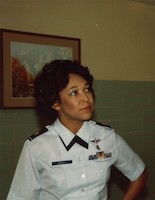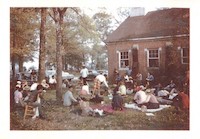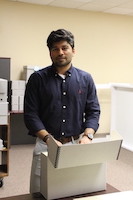

Special Collections Processes Raylawni Branch Collection
News item published on: 2023-08-28 15:19:00Raylawni Branch, a professional nursing educator and an officer in the United States Air Force Reserves, is considered a pioneer of the Civil Rights Movement. In 1965, she became one of the first two African American students to enroll at The University of Southern Mississippi (USM). Throughout her life, she collected materials and photographs documenting her efforts in the Civil Rights Movement and generously donated this collection to University Libraries Special Collections.

Through the National Historical Publications and Records Commission (NHPRC) grant, Abubaker Zahoor, a doctoral student in creative writing, has worked to preserve this important collection. The collection features her correspondence, academic documents, certificates and licenses, publications, Civil Rights ephemera, and materials from Branch’s career in nursing, the military, and academia. Notable items from the collection include an entrance ticket, seating plan, and map for President Obama’s inauguration ceremony, as well as Clyde Kennard’s application for clemency.
The oldest of ten children, Branch was born in Hattiesburg, living in the Mobile Street area, and then raised in Hattiesburg, Prentiss, and Mount Carmel in Mississippi. She also lived in Chicago from the age of six to 14. By the time she completed the eighth grade, her family had moved 11 times. They returned to Hattiesburg after the death of her father, and she graduated from Rowan High School.
After a year USM, Branch moved to New York and became active in the Vietnam War Movement. She later received her bachelor’s degree in nursing from the University of Miami and joined the Air Force Reserves, where she achieved the rank of Lieutenant Colonel. In 1987, Branch returned to Hattiesburg and earned her master’s degree in community health nursing, with a minor in education, from USM in 1993.

During the Civil Rights Movement, Branch participated in many different activities and organizations. She was a part of the March on Washington and integrated the Greyhound and Trailways bus stations in Hattiesburg. She was also the first African American ever hired at the Big Yank clothing factory, as well as the local telephone company. Branch went on to become an instructor of nursing at Pearl River Community College in Poplarville, Mississippi.
The Raylawni Branch collection was selected to be processed with support through a grant from the National Historical Publications and Records Commission (NHPRC). The NHPRC is a statutory body affiliated with the National Archives and Records Administration (NARA) whose mission is promotion of the preservation and use of the country’s documentary heritage essential to understand the nation’s democracy, history, and culture.

Lorraine A. Stuart, Head of Special Collections and Curator of Historical Manuscripts and Archives, is leading the two-year grant project. The purpose of the grant is to increase access to collections and will support processing, digitization, and development of finding aids for existing collections significant to the history and culture of Mississippi. The grant is also providing multiple opportunities for hands-on materials preservation and presentation experiences for the University’s Library and Information Sciences and Humanities graduate students.
Zahoor previously worked in Special Collection, processing the Oseola McCarty collection. When he saw an opportunity to return, he happily accepted. His work on the Branch collection included standard processing, sorting materials, creating a cohesive arrangement plan, and organizing materials in a logical manner that will benefit those using the collection for research.
Zahoor, a student from Pakistan, said, “Working on her collection enabled me to vicariously participate in her fascinating journey that attests to the power of individual will and determination and serves as a reminder that communities based on principles of justice, freedom, and cooperation are essential to our individual and mutual flourishing.”